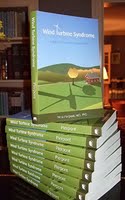Wind Turbine Syndrome
 Clinical study of health effects of large wind turbines published
Clinical study of health effects of large wind turbines published
Rowe, Mass., Nov. 28, 2009 -- Dr. Nina Pierpont, a pediatrician and population biologist in Malone, New York, has announced the publication of her book-length study: Wind Turbine Syndrome: A Report on a Natural Experiment.
In interviews with 10 families living 1,000-4,900 feet away from recently built industrial-size wind turbines, a "cluster" of symptoms was revealed: from sleep disturbance, which affected almost everyone, to headache to tinnitus, vertigo, nausea, irritability, memory and concentration problems, and panic episodes. Industrial wind turbines have a total height of 300-400 feet or more, with blades of 125-150 feet that sweep 1.5-2 acres of vertical airspace.
The book includes supportive reviews and notices by several noted physicians in related disciplines. Although primarily directed towards medical professionals, it includes an informative and often poetic version for the lay audience.
The individuals affected by Wind Turbine Syndrome noticed that they developed symptoms after the turbines near their homes started turning. Symptoms were relieved when they left the area and resumed on their return. Eight of the ten families eventually moved away from their homes because of the severity of the symptoms.
Although not everyone living near turbines is subject to these symptoms, the data Pierpont presents are a concern, considering the current political drive to construct more and ever larger industrial wind turbines close to people's homes, as well as in the habitats of other equally or more sensitive animals.
Pierpont's sample size was large enough to show that individuals with pre-existing migraines, motion sensitivity, or inner ear damage are particularly vulnerable. People with anxiety or other mental health problems are not particularly susceptible, she says, contradicting the common claim of industry developers that "it's all in their head".
"This report is a public health wake-up call that our elected officials and administrators need to take very seriously", said Eric Rosenbloom, president of National Wind Watch, a clearinghouse for information about the adverse effects of industrial wind energy development.
Pierpont and other health and noise experts agree that at a minimum, large wind turbines should be 2 kilometers (1-1/4 miles) from any residence.
According to Pierpont, low-frequency noise or vibration from the wind turbines acts on the balance organs of the inner ear to make the body think it is moving. And this misperception of motion affects other brain functions, including physical reflexes, spatial processing and memory, and physiological fear responses (such as pounding heart and nausea).
Labels: Disadvantages, Process



for this post
Leave a Reply